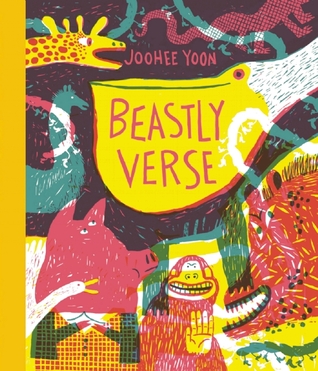Beastly Verse
poems by various authors
illustrations by JooHee Yoon
Enchanted Lion Books, 2015
review copy provided by the publisher
Along with 9 lesser known (to me) or anonymous poets, Lewis Carroll, Ogden Nash, Wiliam Blake, Hilaire Belloc, Christina Rossetti, D.H. Lawrence, and Walter de la Mare all have poems in this vibrantly illustrated collection of beastly verse.
JooHee Yoon used hand drawing and computer techniques and just three Pantone colors for the illustrations, and each page dances and vibrates with color and creativity. Every four or five pages there is a fun gatefold to open up that completes an illustration, or holds a surprise for the reader.
The spread for Eletelephony has a gatefold with a surprise. Before you open the gatefold, you see a living room scene with a telephone ringing. When you open the gatefold, the elephant has attempted to answer the telephone and is completely tangled in the cord!
Eletelephony
by Laura Elizabeth Richards
Once there was an elephant,
Who tried to use the telephant—
No! No! I mean an elephant
Who tried to use the telephone—
(Dear me! I am not certain quite
That even now I’ve got it right.)
Howe’er it was, he got his trunk
Entangled in the telephunk;
The more he tried to get it free,
The louder buzzed the telephone—
(I fear I’d better drop the song
Of elephop and telephony!)
Heidi has the roundup today at My Juicy Little Universe.




.JPG)





